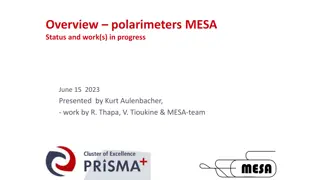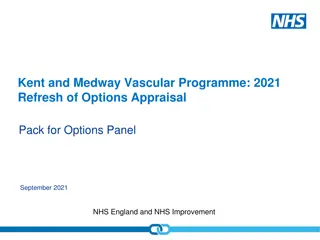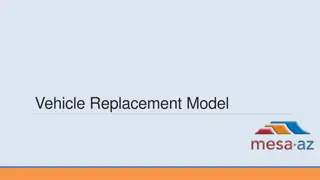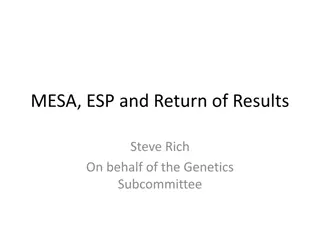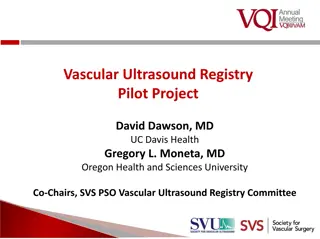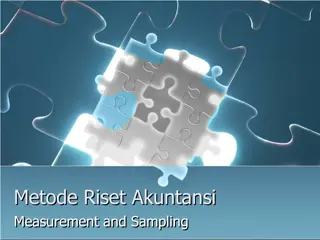Introduction to VaSera for Vascular Function Measurement in MESA Study
Christopher Broadbridge introduces VaSera for vascular function measurement in the MESA study. VaSera, developed by Fukuda Denshi, offers non-invasive diagnostic tests sensitive to cardiovascular risk. The device, equipped with advanced features like CAVI and ABI tests, provides reliable measurements crucial for assessing arterial stiffness and diagnosing conditions such as atherosclerosis and coronary artery disease.
Download Presentation

Please find below an Image/Link to download the presentation.
The content on the website is provided AS IS for your information and personal use only. It may not be sold, licensed, or shared on other websites without obtaining consent from the author. Download presentation by click this link. If you encounter any issues during the download, it is possible that the publisher has removed the file from their server.
E N D
Presentation Transcript
Introduction to VaSera for Use in the MESA Study Christopher Broadbridge Phone: (425) 241-7396 Clinical Development & Marketing, VaSera Fukuda Denshi USA Redmond, WA
Fukuda Denshi 3,000+ employees worldwide (including 300 engineers) Celebrated 75thYear Anniversary ECG leader in Japan First ECG producer in Japan (1939) Reputation for quality engineering Oldest bedside monitoring manufacturer in the world Makes 300+ medical device products
Rolling cart Touch screen Data transfer: Removable USB Data storage: 2 USB, 1 SD, internal 4
6 ultra-sensitive cuffs (brachia, thighs, ankles) 1 heart-sensitive microphone Ankle cushions and wrist cushions
Characteristics of VaSera Tests Diagnostic Non-invasive Validated Reproducible Sensitive to CV risk Reimbursed in USA FDA approved 6
CAVI A heart-to-ankle measurement: Direct, single-path from the point of origin Includes the whole aorta
VaSera tests to perform 1. CAVI test (Cardio-Ankle Vascular Index): For arterial stiffness diagnosis ( atherosclerosis; CAD) 2. Thigh-cuff test (Cardio-Thigh Vascular Index): For arterial stiffness diagnosis ( atherosclerosis; CAD) 3. ABI test: For peripheral artery disease diagnosis (PAD) 8
Why do the measurement? CAVI is a possible predictor of coronary risk; fully automatic. Cardio-thigh stiffness measurements may be as effective as well-measured cfPWV. VaSera ABI s are automated; easier for clinics to perform. Clean brachial waveforms from VaSera may provide data to predict HF
For adults, CAVI is an independent risk marker for: 1. Coronary artery disease 2. Future cardiovascular events in people with CAD 3. Atherosclerosis in HTN patients 4. Renal dysfunction (eGFR) / Chronic Kidney Disease (CKD) REFS: 1. Yingchoncharoen T, Limpijankit T, Jongjirasiri S, Laothamatas J, Yamwong S, Sritara P. Arterial stiffness contributes to coronary artery disease risk prediction beyond the traditional risk score (RAMA-EGAT score). Heart Asia. 2012 Feb 21;4(1):77-82. Print 2012. 2. Otsuka K, Fukuda S, Shimada K, Suzuki K, Nakanishi K, Yoshiyama M, Yoshikawa J. Serial assessment of arterial stiffness by cardio-ankle vascular index for prediction of future cardiovascular events in patients with coronary artery disease. Hypertens Res. 2014 Jul [Epub ahead of print] 3. Okura, T; Watanabe, S; Kurata, M; Manabe, S; Koresawa, M; Irita, J; Miyoshi, K; Fukuoka, T. Relationship between Cardio- Ankle Vascular Index (CAVI) and Carotid Atherosclerosis in Patients with Essential Hypertension. Hypertens Res; 2007; (30): 335-340 4. Takuro K, Masaaki M, Kiyo U, Aya N, Shuichi H, Ken K, Osamu K, and Chuwa T. Association between Arterial Stiffness and Estimated Glomerular Filtration Rate in the Japanese General Population. J Atheroscler Thromb, 2009; 16:840-845.
CAVI Health Subject Data 11 Cardio-Ankle Vascular Index (CAVI) Healthy Subject Study Results (Japan) Healthy Subject Study Results (Japan) Healthy Subject Study Results (Japan) Cardio-Ankle Vascular Index (CAVI) Healthy Subject Study Results (Japan) (Men=3,259; Women=3,534) (Men=3,259; Women=3,534) (Men=3,259; Women=3,534) (Men=3,259; Women=3,534) Cardio-Ankle Vascular Index (CAVI) Cardio-Ankle Vascular Index (CAVI) 10 9.35 9.01 9 8.6 Male 8.71 8.15 Female 7.99 8.37 8 8.21 7.72 CAVI Value CAVI Value CAVI Value 7.5 7.95 7.74 7.23 7.02 7.38 6.81 7 7.22 7.04 6.86 6.37 6.72 6.27 6 5 20-24 25-29 30-34 35-39 40-44 45-49 50-54 55-59 60-64 65-69 70-74 AGE (yrs) AGE (yrs) AGE (yrs) AGE (yrs)
(Tips on testing) MESA version Document Number: USRB-0074-00 12
Background What is CAVI? How is it measured? Document Number: USRB-0074-00 13
4 ultra-sensitive cuffs 1 heart-sensitive microphone ECG for gating signals 14 Document Number: USRB-0074-00
Document Number: USRB-0074-00 CAVI A heart-to-ankle measurement: Direct, single-path from the point of origin Includes the whole aorta 15
When VaSera detects the second heart sound, we have the time of closure of the aortic valve. A high quality brachial pulse waveform will show, with its dichrotic notch, when that closure s effect occurs in the brachium. Time of the second heart sound to dichrotic notch represents, then, a lag time . Applying that lag time to the start of the rise of the brachial pulse wave (the foot of the brachial wave), the time of expulsion of blood at the level of the aortic valve (valve opening time) is extrapolated. Thus, with aortic valve- opening time being time zero, we can easily measure the pulse s total transit time to the ankle, where it is measured until the foot of the ankle wave. Transit distance is estimated using the subject s height, or can be done more exactly from manual measurements. Dividing this distance by transit time gives the pulse wave velocity (PWV). The beta stiffness index and scale adjustments are added to give CAVI more independence from blood pressure and make it comparable to heart-to- femoral PWV. The CAVI measurement is that of a pulse movement along a single path, and includes the whole aorta. Document Number: USRB-0074-00 16
Performing the Measurement Before pressing START button: Quiet room Ensure cuffs correctly wrapped and positioned Patient: Supine, Still, Relaxed Ensure that PCG = distinct 2nd heart sound Brachials = dichrotic notch Ankles = defined starting point to each pulse Thighs = clean, smooth, regular signals Document Number: USRB-0074-00 17
Clean Waveforms and Signals Up-going R-wave; In sinus rhythm Distinct 2nd heart sound; flatter baseline Noticeable dichrotic notch; no disruptive artifacts on the downslope Sharp and consistent foot , marking the up-slope, with no disruptive artifacts Document Number: USRB-0074-00 18
Always check your PCG signal If you can t distinguish the 2nd heart sound, VaSera probably can t either. Document Number: USRB-0074-00 19
Look at the Brachial Waveforms Can you distinguish the dichrotic notch from the artifact? Document Number: USRB-0074-00 20
Good Ankle Signal (foot/ trough)? No Yes Are the troughs or feet of the ankle waveforms at the ends of consistent and regular up-slopes? Document Number: USRB-0074-00 21
Movement Artifact Effect Movement, beyond relaxed breaths, can disrupt signals Document Number: USRB-0074-00 22
Arrhythmia Effect Arrhythmic heart beats result in irregular pulse waveforms Document Number: USRB-0074-00 23
Measurement Review AFTER CAVI measurement period: Ensure that Blue, data quality-check screen shows pluses + for both sides (R and L) If a minus is shown, press STOP button, and start the test over by adjusting where necessary and pressing START button If there is a minus sign for either side, do not use this test result Document Number: USRB-0074-00 24
Document Number: USRB-0074-00 You may also review calculation results via the VALUE screen. One column per heartbeat (1-6). These symbols are quality measures: = . Red values (outliers) are not used in the reported results. is the same as ++ , = + , = , 25
Performing Tests with Thigh Cuffs (See the Thigh Cuff Protocol document) Thigh cuffs are used in this study in order to assess measurements with a heart-to-femur transit (more purely aortic in nature than measurements using a heart-to-ankle transit) Thigh cuffs must be applied as carefully as brachial and ankle cuffs are applied
VaSera Data Management for the MESA Study (From the VaSera collection device to MESA central data repository)
Please use these site # assignments Site# Site Name Northwestern University Clinic 1 Columbia University Clinic 2 Johns Hopkins University Field Center 3 University of Minnesota (Epidemiol. Clin.Res. Cntr) 4 UCLA Clinic 5 Wake Forest University Clinic 6
At each site Zip Files ZIPPED VaSera USB data stick For all VaSera data, create consistent, date-sortable, folder-naming format: e.g., 20160915-UCLA 1. 2. Remove USB drive/Stick from front of VaSera. Use File Manager to copy files from USB drive to a folder you designate for VaSera data on your PC. Name that folder MESA Study VaSera Data . Zip/compress the files in your PC folder to make them ready for transfer. Upload the zipped folder to your MESA central data storage location. Repeat the above steps, on a regular basis, keeping all historical data. 3. 4. MESA Study VaSera Data 5. 20160915-UCLA 6. Send to Center
MESA Central Data Storage Location UCLA-5 ZIPPED 20160915-UCLA Unzipped 20160915-UCLA upload 20161030-UCLA ZIPPED Unzipped 20161030-UCLA 20161013-JHU ZIPPED CU-2 NWU-1 20161104-UCLA ZIPPED CU-2 Unzipped 20161116-CU 20161028-WFU ZIPPED JHU-3 WFU-6 20161116-CU ZIPPED
VSS-50 management UCLA-5 20160915-UCLA Aug5 2016_Pennsylvania Import with VSS-50 software JHU-3 Review, Print, or Export in various data formats 20161224-JHU Graphic files Wave Data files Inspection Data spreadsheet
Some Extra Tips 1. Sites not using the AUTO-TRANSFER of data from VaSera to PC: Remove auto transfer option from the system settings 2. Change Site ID # for each site according to table above: MENU SETTINGS PATIENT INFO 3. For Thigh-cuff measurements, make sure to measure to/from the middle of the thigh cuff 4. BP VESSEL LENGTH setting Make sure to input the correct subject HEIGHT information; this is critical to the test result 5. PAUSE the test at the CAVI DATA CHECK SCREEN ( SUMMARY SCREEN ); this will enable an opportunity to review data quality and decide if to stop and restart the test after adjustments, or to continue with the test to completion. 6. Preview the PDF file Report to see if the CAVI result is reported with a circle (signifying clean data ) or no circle (questionable data quality). 7. Data will be saved to USB1, USB3, SD card, and to the VaSera internal memory. 8. A good VaSera test time for each subject is 8 (CAVI test) + 2 (rest between measurements) + 8 (thigh cuff test) = 18 minutes
Let us support you Please pose your questions to your local Fukuda Denshi USA representative: Christopher Broadbridge FUKUDA DENSHI USA, Inc. Tel: (425) 241-7396 Fax: (425) 556-3213 CBroadbridge@fukuda.com Or contact our customer service at: Toll Free : 1-800-365-6668 Local : 425-881-7737 Hours: 8:00 AM to 5:00 PM (PST) Document Number: USRB-0074-00 33



